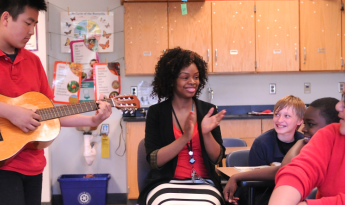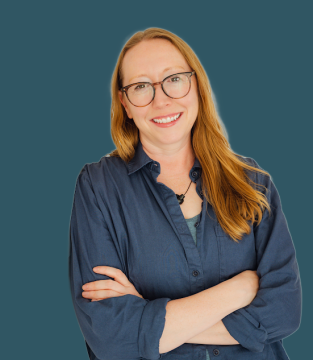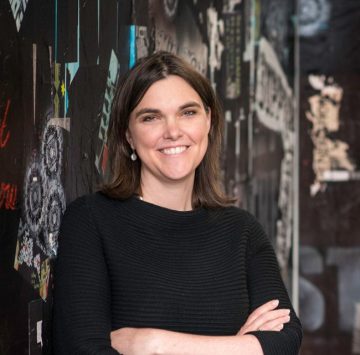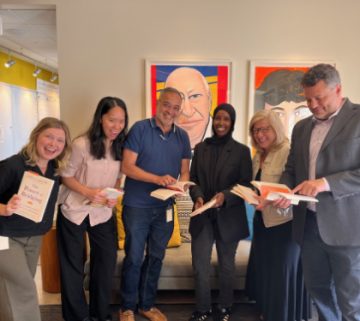Story
Reflecting Student Diversity
DATE
December 20, 2019

Patrick Duffy and his colleagues at the Saint Paul Public Schools (SPPS) have been working for years to solve a puzzle common across K-12 schools — in an urban district where the academic achievement gap splits along racial and ethnic lines, how it can diversify the teaching workforce to better serve its students.
“We think it’s important in boosting achievement for our students of color that they see themselves reflected in the curriculum and instruction,” says Duffy, director of leadership development for Saint Paul Public Schools. “To do that, we need to hire teachers whose life experiences reflect our students’ lives.”
“We need to find and support new teachers who are going to serve and strengthen schools and communities at the highest levels.” – Patrick Duffy, Saint Paul Public Schools
Seventy-four percent of SPPS students are students of color, while the teaching staff is 93.7 percent white. Duffy and his colleagues believe that building an ethnically diverse workforce of qualified teachers is key to boosting achievement across racial lines. But it’s not always easy to find teachers of color.
The Foundation’s midpoint evaluation of the Teacher Effectiveness Initiative (TEI) validated that reality. “We heard loud and clear that K-12 districts wanted more teachers of color, and higher education was struggling to meet that demand,” says Kayla Yang-Best, the Foundation’s education director. In response, the Foundation created a supplementary grant program to develop new, groundbreaking strategies that increase teacher diversity. (The program is open to organizations working with one of the 14 TEI partners.) SPPS is among the five organizations funded under this supplemental program and has teamed with the Twin Cities Teacher Collaborative (TC2), a partnership of six institutions of higher education.
Together, SPPS and TC2 will develop new ways for professionals of color to pursue teacher training and certification. These potential teachers may not come to SPPS through traditional teacher training. Instead, individuals with an understanding of the communities the schools serve and who demonstrate interest and skills in working with children may be encouraged to consider new teacher-training programs co-designed by the organizations.
“We are looking at folks who are currently working in the district in paraprofessional positions,” Duffy explains. “We are also looking at community members already working with students as parents or volunteers. These people might not have completed college degrees, but they have expressed an interest in working as teachers. We want to help them achieve that goal.”
Through this new partnership, teacher trainees will earn their teaching degrees at a TC2 institution, to be named during the planning year. Participants will work with a team of advisors, including “master” teachers with years of experience working in the district. Duffy hopes that this added mentoring will help boost graduation rates for participants and ensure an influx of new, culturally diverse teachers to the district.
Offering multiple, supported ways for individuals invested in communities of color to become teachers feels like a good starting point for educational transformation in the district, Duffy says. “The teacher candidates will already have the commitment they need to succeed. And once they go through a university program, they will have a greater understanding of the will, skills, knowledge and capacity it takes to be a strong teacher in Saint Paul Public Schools.”
The district’s achievement gap justifies this approach. Duffy says, “We realized that in order to make measurable improvements, we need to do something that goes beyond ‘tweaks’ to the system. We need to make bold leadership decisions that ensure that we’re supporting our existing teachers to be the best teachers they can be for the students in their classrooms. And we need to find and support new teachers who are going to serve and strengthen schools and communities at the highest levels. This partnership has the potential for great change.”

Great Teachers Great Minds
Even before there was a Bush Foundation, Archibald Bush invested in education, through supporting both individuals of promise and educational institutions.
Continue reading
-

News
Welcome to new Bush staff members
We are celebrating some new Bush colleagues and hope you get to meet them soon!
-

Note from Jen
Protecting our freedom to give
Do you know how CPR came to be? What about the 911 system? Ever wonder who developed the Pap smear? Or why school buses are all the same color? All these were the results of work funded by some foundation.
-

News
Introducing the Bush book club
Join us as we learn how to build a world where we all belong. And stay tuned as we get ready to welcome john a. powell to Minnesota for a special Bush book club event!